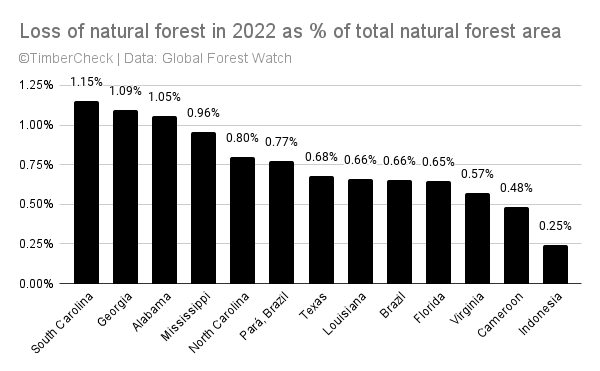In 2022, the U.S. Southeast lost a higher percentage of its natural forest area than the deforestation hotspots of Brazil, Cameroon, and Indonesia. In fact, the state of South Carolina lost 1.15% of its natural forest area, while the Brazilian Amazonian state of Pará lost just 0.77%.

Although forest change in the United States has been overlooked relative to other major timber producing countries, a new law in the European Union suddenly brings U.S. forest degradation into focus.
The E.U. Deforestation Regulation
The European Union has banned the importation of wood products from deforestation and forest degradation under a new law called the E.U. Deforestation Regulation (EUDR).
Furthermore, the law requires intensive due diligence be conducted on supply chains if the product originates from a country, or parts thereof, that’s been classified as “high-risk” by the EUDR benchmarking system.
One of the criteria to determine risk is rate of forest degradation. Given that the U.S. Southeast is losing its natural forest area faster than places like Brazil, there’s a good chance that U.S. wood product supply chains will be classified as high risk.
Natural forest loss and ‘forest degradation’
The data used to calculate natural forest area loss in the U.S. southeast in 2022 as a percent of its total natural forest area is sourced from Global Forest Watch. The data is a measurement of tree cover loss. Tree cover loss can occur in plantation forests and natural forests. Natural forest loss, as reported by GFW, accounts for tree cover loss in natural forests.
Tree cover loss, whether in plantation forests or natural forests, is not always deforestation. But under the EUDR, tree cover loss is forest degradation if it results in a change of “(a) primary forests or naturally regenerating forests into plantation forests or other wooded land; or, (b) primary forests into planted forests,”.
What does forest degradation in the U.S. Southeast look like?
In 2022, Virginia lost a higher percentage of its’ natural forest area (0.57%) then did Cameroon (0.45%), and Indonesia (0.25%) .
The following image shows a 2022 central Virginia timber harvest of a naturally generated mixed pine-hardwood forest.


Although it can’t be ruled out from this satellite image that this land will not be managed for a mixed pine-hardwood forest type, it appears that it will be converted to a pine plantation given: (a) there is no discernible hardwood regeneration present; and (b) the historical pattern of conversion to pine plantation in adjacent lands as seen in the following image.


Conversion of naturally generated forests to pine plantations is the most common land conversion by area in the U.S. Southeast. Between 2000 and 2018 – in a fuel catchment area spanning much of the piedmont and tidewater region of Virginia and North Carolina – planted pine timberland increased 339,055 hectares (+35%) while naturally regenerated hardwood timberland decreased 246,383 hectares (-11%).
Wood from forest degradation will be illegal in the EU from 2025
Starting in 2025, it will be illegal in the European Union to import wood from forest degradation that has occurred after December 31, 2020. European buyers of U.S. wood products will need to understand whether the product they are purchasing originated from degraded forest lands as defined by the EUDR.
(Contact for more forest product supply chain and timber due diligence.)
Given that the rates of natural forest loss in parts of the United States exceed that of deforestation hotspots like Brazil, avoiding product from forest degradation in the U.S. Southeast is likely to be difficult, and lead to significant changes in global wood product flows.

TimberCheck – Forest product supply chain data for timber due diligence. Contact.
Have a problem with this post? Suggestions on how to improve this article? Please leave a comment below.

Leave a Reply